The Present is Now and, in fact, as soon as “it is,” it becomes “it was,” so much that one feels it did not exist, as a continuum. Not only daily life needs lead the mind’s pathways and actions; the human being requires justifying them, too.
—Arthur Schopenhauer, The World as Will and Representation [2]
Arthur Schopenhauer (1788–1860), a transcendental German philosopher, is best known for his 1818 work The World as Will and Representation, or in German, Die Welt als Wille und Vorstellung (expanded in 1844), wherein he characterizes the phenomenal world as the product of a blind and insatiable metaphysical will [1]. Such a phenomenal world is the world as it appears to human beings, who are structured by their own understanding. It is the world as experienced, as opposed to the world of things-in-themselves. In turn, the metaphysical will tries to explain the fundamental nature of being and the world of experience. For this reason, it is never precisely defined in contingent terms (i.e., things likely but not certain to happen); in simpler words, it refers to first principles. Summarizing (and it deserves to be said in five languages to better emphasize its meaning),
- The world manifests itself as a representation of the authentic reality given by the will.
- Die Welt zeigt sich als Vorstellung der wahren Wirklichkeit durch den Willen gegeben.
- El mundo se manifiesta como representación de la realidad auténtica dada por la voluntad.
- Il mondo si manifesta come rappresentazione della vera realtà data dalla volontà.
- Le monde apparaît comme une représentation de la vraie réalité compte tenu de la volonté.
Overview: Schopenhauer and His Work
The main objective of this article, as its title suggests, is to find in Schopenhauer’s momentous opera magna, already more than 150 years old, any element historically and/or epistemologically related to the current concepts of bioengineering or biomedical engineering and/or biotechnology [2]. We have used only concepts and ideas put forward by Schopenhauer in the first 16 chapters of Volume 1. The rest, including Volume 2, was not deemed pertinent to our objective, with the author going into deep and difficult philosophical matters that would have taken us away from this much more modest intent.
Chapter 1 states that “the world is my representation.” It is what I think or feel it is, and such thought means that philosophical discernment has appeared in me. However, I do not really know what the world or the parts forming it really are. Thereafter, Schopenhauer divides the representation into object and subject. Everything is object in relation to the subject, the perceiver: the world is representation, Vostellung. Besides, there is also transcendental ideality within this setting, that is,
- something surpassing, or superior
- something being beyond ordinary or common experience, thought, or belief
- something abstract or metaphysical
- something beyond the contingent or accidental, but not beyond human knowledge.
Transcendental idealism is a term applied to the epistemology of the 18th century German philosopher Immanuel Kant (1724–1804), who held that the human self, or transcendental ego, constructs knowledge out of sense impressions. Moreover, a man or a woman can say, “The world is my will.” And the world is the knowable. At the end of Chapter 1, Schopenhauer writes, “On one side, the world is entirely representation; on the other, it is entirely will.” Yes, will, because I or you or someone else does want to know about the object, but each of us is able only to get a mere representation of it.
Chapter 2 begins with a statement of double and ambiguous interpretation:
That which knows all things and is known by none is the subject. It is accordingly the supporter of the world, the universal condition of all that appears, of all objects, and is always presupposed; for whatever exists, exists only for the subject.
Two possible interpretations arise immediately:
- It sounds like a description of a Supreme Being.
- It sounds as if we all are, or each of us is, the one knowing all things (or thinking of knowing all things), but this is known by no one else; however, each of us is the subject. Obviously, then, we (the Earth’s population) are the supporters of the world, and everything else points toward us as the subject.
The author adds, “Everyone finds himself/herself as this subject, yet only in so far as he/she knows, not in so far as he/she is object of knowledge.” However, he underlines that the individual considers himself/herself only the subject, not the object. Therefore, we face two inseparable parts: one half is the object in space and time, and the other half is the subject, which does not lie in space and time, for it is whole and undivided in every representing being.
The latter part raises many doubts, especially regarding space, time, and lack of division. Hence, accepting the whole thought, a single one of these beings (each of us, or we as part of the world population), with the object, completes the world as representation just as fully as do the millions that exist. This sentiment bestows each person with an outstanding significance. (If one recalls the current advances regarding the universe, its many galaxies and systems, the previous statement sounds hugely egocentric and even comical or medieval.)
In Chapter 3, Schopenhauer stresses that “the intuitive and the abstract can be not only thought in the abstract, but also can be directly perceived.” Here, a first tenuous relationship with bioengineering, biomedical engineering, and/or biotechnology is encountered because such an idea constitutes a fundamental characteristic within the latter areas, where intuition and abstraction must go hand in hand. Mathematics and physics strongly rest on such qualities, as do most of the disciplines concerned with the aforementioned fields. Time takes us to the past and the future, which are empty and unreal, for the present is only the boundary between the two. The present is now, and, in fact, as soon as “it is,” it becomes “it was,” so much that one feels it did not exist as a continuum. Thus, it was chosen as one of the epigraphs of the article.
The second one finds its answer more easily, more romantically, and, among many populations, in religious beliefs. Unfortunately, a not-insignificant human sector crossed the dangerous line of blind fanatic fundamentalism.
Who Was Arthur Schopenhauer?
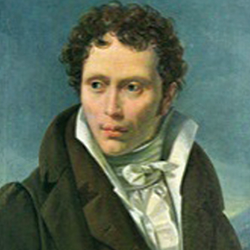
Arthur Schopenhauer (pictured left) was born in Danzig, now Gdansk, Poland, in 1788, passing away in Frankfurt, Germany, in 1860. His father, Heinrich Floris Schopenhauer, was a rich businessman who later moved the family to Hamburg, when Danzig fell into the hands of Prussia, in 1793. His mother, Johanna Schopenhauer (née Trosiener), was a writer of relative fame, but she did not get along well with her son. However, the literary salon or hall she founded in Weimar offered the philosopher the chance of meeting several personalities, Goethe among them.
Against his wishes, Schopenhauer started a commercial career in 1805 forced by his father, whose death, apparently a suicide, allowed the son to get into Göttingen University as a medical student in 1809. However, reading Plato (c. 428 BCE–c. 348 BCE), Socrates’ disciple, and Kant led him into philosophy. Already in Berlin in 1811, he began courses with Johann Gottlieb Fichte (1762–1814) and Friedrich Daniel Schleiermacher (1768–1834). Unfortunately, both found him deficient, although the causes were not clear, and for some time he moved away from philosophy. The Napoleonic campaigns were a good excuse for retiring to Rudolfstadt, a place where he produced his doctoral dissertation, On the Fourfold Root of the Principle of Sufficient Reason (Auf der vierfachen Wurzel des Grundsatzes der zureichenden Vernunft), at Jena University, published in 1813.
Afterward, he returned to Weimar, where he developed a close friendship with Goethe. His mother told him his doctoral book was incomprehensible and it was unlikely that anyone would ever buy a copy. In a fit of temper, Schopenhauer answered back that his work would be read long after the rubbish she wrote was totally forgotten. The incident further strained their relationship.
In fact, although the directors considered her novels of dubious quality, the Brockhaus Publishing firm held Johanna in high esteem because her books consistently sold well. Hans Brockhaus later recalled that when she brought the publisher her son’s work, his “predecessors saw nothing in it, but wanted to please one of their best-selling authors.” Later, in 1814, Schopenhauer began his seminal work The World as Will and Representation, which he finished in 1818 and Brockhaus published in December 1918 in Dresden. Today nobody remembers Johanna, but her son’s works are in steady demand (and, at the time, contributed to Brockhaus’s reputation), fully verifying Arthur’s prediction [3].
Schopenhauer fathered, with a servant, an illegitimate daughter who was born and died the same year. In 1820, he became a lecturer at the University of Berlin. He scheduled his lectures to coincide with those of the famous philosopher Georg Wilhelm Hegel (1770–1831), whom Schopenhauer described as a “clumsy charlatan.” Regrettably, only five students turned up for Schopenhauer’s lectures, and he dropped out of academia. A late essay, “On University Philosophy,” expressed his resentment toward the work conducted in academies. Of the universities we now have worldwide, perhaps most or, at least, many deserve similar criticism to a greater or lesser degrees, proving Schopenhauer’s farsightedness.
While in Berlin, Schopenhauer was named as a defendant in a lawsuit initiated by a woman named Caroline Marquet. She asked for damages, alleging that Schopenhauer had pushed her. According to Schopenhauer’s court testimony, she deliberately annoyed him by raising her voice while standing right outside his door. Marquet accused the philosopher of assaulting and striking her after she refused to leave his doorway. After Marquet won the lawsuit, Schopenhauer had to pay her regular installments for the next 20 years! When she died, he wrote on a copy of her death certificate, obit anus, abit onus (The old woman dies, the burden is lifted).
In 1819, the fortunes of his mother, sister, and himself were threatened by the failure of the firm in Danzig where his father had been a director and shareholder. His sister accepted a compromise compensation package of 70%, but Arthur angrily refused; eventually, he recovered a portion.
In 1821, he fell in love with a 19-year-old opera singer, Caroline Medon (real name Caroline Wilhelmine Richter, 1802– 1882). Medon came to Berlin around 1819 as a chorister at the Staatsoper Unter den Linden. It was there that she met Schopenhauer, probably in 1820 or spring 1821, when he lectured in Berlin. The on-and- off relationship, with many ups and downs between the two, lasted about ten years. The eternal bachelor Schopenhauer, however, mistrusted her, possibly with worries about her health and jealousy of the singer’s other lovers; thus, no engagement or marriage ever came about. Besides, their relationship was characterized by almost permanent turmoil. She ultimately became successful as a soloist at the Königsstädtisches Theater.
Thereafter, when he was 43 years old, Schopenhauer took interest in Flora Weiss, a beautiful, spirited girl who had just turned 17. During a boating party, in an attempt to charm her, he smiled and offered her a bunch of white grapes. Weiss later confided in her diary, “I didn’t want them. I felt revolted because old Schopenhauer had touched them, and so I let them slide, quite gently, into the water behind me.”
In 1831, a cholera epidemic broke out in Berlin, and Schopenhauer left the city, eventually settling in Frankfurt in 1833; there he remained for the next 27 years, living alone except for a succession of pet poodles. The numerous notes he made during these years, on aging and other topics, were published posthumously under the title Senilia. Schopenhauer had a robust constitution, but in 1860 his health began to deteriorate, and he died of respiratory failure on 21 September 1860, while sitting at home on his couch. He was 72 years old.
Some of Schopenhauer’s Ideas
It used to be said that metaphysics encompasses
- the subject matter of being as such
- the subject matter of the first causes of things
- the subject matter of that which does not change.
All this makes up a rather complex set of extremely difficult concepts, really not relevant for the present discussion. Proceeding from Kant’s transcendental idealism, Schopenhauer developed an atheistic metaphysical and ethical system that mainly describes philosophical pessimism, rejecting the so-called German idealism. Although his work failed to garner substantial attention during his life, Schopenhauer has had a posthumous impact across various disciplines, including philosophy, literature, and science. Those who have recognized his influence include, among others, outstanding characters from different disciplines:
- Friedrich Nietzsche (1844–1900), philosopher
- Richard Wagner (1813–1883), composer and conductor who revolutionized opera through his concept of Gesamtkunstwerk, or total work of art
- Leo Tolstoy (1828–1910), Russian novelist
- Ludwig Josef Wittgenstein (1889– 1951), Austrian-British philosopher who worked in logic, the philosophy of mathematics, and the philosophy of mind and language
- Erwin Schrödinger (1887–1961), Austrian theoretical physicist who contributed to the wave theory of matter and to other fundamentals of quantum mechanics and shared the 1933 Nobel Prize for Physics with the British physicist Paul Dirac (1902–1984) [4]
- Gustav Mahler (1860–1911), Austrian late-Romantic composer who, as a musician, acted as a bridge between the 19th century Austro-German tradition and the modernism of the early 20th century
- Albert Einstein (1879–1955), the world-famous German-American physicist who was awarded the 1921 Nobel Prize for Physics, renowned for his theory of relativity, and an influential humanist speaking widely about politics, ethics, and social causes
- Jorge Francisco Isidoro Luis Borges Acevedo (1899–1986), Argentine short-story writer, essayist, and poet, who became a key figure in Spanish-language literature and whose works have contributed to philosophical literature and the fantasy genre.
Schopenhauer’s ideas, beliefs, and actions during his life are full of conflicts and contradictions, and many of them would trigger strong reactions among many 21st century thinkers, philosophers, scientists, and even common people. Even so, he stands as a solid and highly respected pillar of philosophy. Perhaps our current world has changed too much and too fast by far.
He believed that humans are motivated only by their own basic desires, or Wille zum Leben (will to live), which direct all of humankind. For him, human desire was futile, illogical, and directionless, and, by extension, so was all human action in the world. Einstein paraphrased this view as “man can indeed do what he wants, but he cannot will what he wants.” To Schopenhauer, the will is a blind force that controls not only the actions of individual, intelligent agents but also, ultimately, all observable phenomena; it is an evil to be terminated via asceticism—although his own life was not precisely an example of asceticism!
In Chapter 6 of his transcendental book, for example, Schopenhauer asserts that we consider everything merely as representation, as object for the subject. Even our own body is, for us, a representation. The immediate consciousness of the changes of the body makes it an immediate object. Later in the chapter, he touches on several aspects that definitely belong to the field of cerebral neurophysiology, thus, in a way, slightly touching bioengineering and biomedical engineering. Verbatim he states, “That which is correctly known by understanding is reality. Error is opposed to truth, as deception of reason; illusion is opposed to reality as deception of understanding.”
As background material, he also refers to his essay “On Vision and Colors,” a typical physiology theme (Über das Sehen und die Farben), published in May 1816 when the author was 28 years old. He had extensive discussions with Goethe about the subject, basically sharing Goethe’s views. Schopenhauer tried to demonstrate physiologically that color appears as a specially modified activity of the retina, bringing his thoughts closer to what concerns this article [5].
For Schopenhauer, human desiring, willing, and craving cause suffering and even pain. A temporary way to escape this pain is through aesthetic contemplation because it stops one from perceiving the world as mere presentation; instead, one no longer perceives the world as an object of perception. Art is the practical consequence, as it attempts to depict one’s immersion in the world. Music, for Schopenhauer, was the purest form of art because it displayed the will itself without appearing as subject. Music, he insisted, was a timeless, universal language comprehended everywhere that could imbue global enthusiasm. A superb concept, indeed!
Mathematics
Schopenhauer’s realist views on mathematics are evident in his criticism of contemporary attempts to prove the parallel postulate of Euclidean geometry. Writing shortly before the discovery of hyperbolic geometry demonstrated the logical independence of the axiom and long before the general theory of relativity revealed that it did not necessarily express a property of physical space, Schopenhauer criticized mathematicians for trying to use indirect concepts to prove what he held to be direct evidence from perception.
The Euclidean method of demonstration has brought forth the famous controversy over the theory of parallels and in attempts to prove the 11th axiom (also known as the fifth postulate). The axiom asserts that two lines inclined to each other, if produced far enough, must meet. No proof is needed, merely because there is nothing more immediate, affirms Schopehauer:
In two-dimensions, if a line segment intersects two straight lines forming two interior angles on the same side that sum to less than two right angles, then the two lines, if extended indefinitely, meet on that side on which the angles sum to less than two right angles.
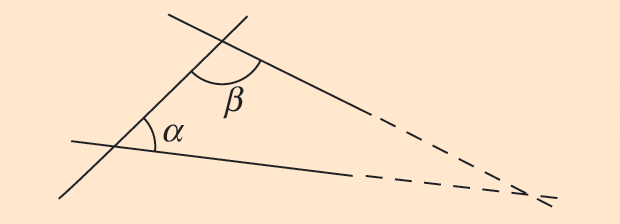
This postulate does not specifically talk about parallel lines; it is only a postulate related to parallelism (Figure 2). This subject also hints at the disciplines we try to deal with here, searching for their possible philosophical-epistemological background.
Compassion and Self-Interest
Then, Schopenhauer leaps to a human concept of profound consequences: “Twisted brains, blood, and brawn are the trio [‘triumvirate,’ says Schopenhauer] necessary for corruption and confusion.” History reminds us of dreadful examples without going back too far in time: Vladimir Lenin and Joseph Stalin (Soviet Union); Adolf Hitler (Germany); Benito Mussolini (Italy); Fidel Castro (Cuba); Hugo Chávez and Nicolás Maduro (Venezuela); Juan Carlos Onganía, Rafael Videla, and his criminal associates (Argentina); and many others that wander about here and there as potential threats to humankind. Schopenhauer’s moral theory proposed that only compassion can drive moral acts. Accordingly, compassion alone is the good of the object of acts; that is, they cannot be inspired by the prospect of personal utility.
Humankind can also be guided by egoism and malice. Egotistic acts are those guided by self-interest, a desire for pleasure or happiness. Acts of malice are different from egotistic acts. As in the case of acts of compassion, these do not target personal utility. Their aim is to cause damage to others, independent of personal gain. Schopenhauer believed that the ego is the origin of pain and conflicts; its reduction frames the moral principles. A definite action inevitably results when a particular motive influences a person’s given unchangeable character.
The State, Schopenhauer claimed, punishes criminals to prevent future crimes. The law and its fulfillment and punishment are directed essentially to the future, not to the past. This distinguishes punishment from revenge, for revenge is motivated by what has happened and hence by the past as such. The object of punishment is deterrence from crime. Object and purpose for the future distinguish punishment from revenge, and punishment has this object only when it is inflicted in fulfillment of a law. Only in this way does it proclaim itself to be inevitable and infallible for every future case; thus, it obtains for the law the power to deter.
Should capital punishment be legal? “For safeguarding the lives of citizens,” Schopenhauer asserted, “capital punishment is therefore absolutely necessary.” “The murderer,” he wrote, “who is condemned to death according to the law must be now used as a mere means, and with complete right, for public security.” Schopenhauer disagreed with those who would abolish capital punishment: “Those who would like to abolish it should be given the answer, ‘First remove murder from the world, and then capital punishment ought to follow.’” People, according to Schopenhauer, cannot be improved. They can only be influenced by strong motives that overpower criminal motives. Rehabilitation did not even find a place in his mind, and practical current experience would not reassert the concept, no matter how much it hurt both Christian and human standings.
Free Will and Destiny
Schopenhauer ended his treatise on the freedom of human I, with the postulate that everyone is responsible for his or her character and acts, the responsibility following from the will as noumenon. He considered his views incompatible with theism on the grounds of fatalism and, more generally, responsibility for evil. For him, the dogmas of Christianity lose their significance, and the Last Judgment is not preceded by anything, as “the world is itself the Last Judgment,” whereas God, if existant, would be evil. Quite a shocking concept, for it stands in opposition to the possibility of a Good Supreme Being, revealing a harmful, noxious (schädlich) being instead. Noumenon (plural noumena), in Kantian philosophy, stands for the thing in itself (das Ding an sich) as opposed to what Kant called the phenomenon (the thing as it appears to an observer).
The Will to Live
Schopenhauer named sex a force within humans that he felt took invariable precedence over reason: the will to live or will to life (Wille zum Leben) is defined as an inherent drive within human beings— and, indeed, all creatures—to stay alive, a force that entices us into reproducing, an immensely powerful force that lies unseen within the human psyche and dramatically shapes the world. What is decided by it is nothing less than the composition of the next generation. These ideas foreshadowed the discovery of evolution, Freud’s concepts of the libido and the unconscious mind, and evolutionary psychology in general.
Racial and Cultural Biases
Schopenhauer attributed civilizational primacy to the northern “white races” due to their sensitivity and creativity (except for the ancient Egyptians and Hindus whom he saw as equal). The highest civilization and culture, apart from the ancient Hindus and Egyptians, are found exclusively among the white races; and, even with many dark peoples, the ruling caste or race is fairer in color than the rest. All this is because necessity is the mother of invention. Those tribes that emigrated early to the north, and there gradually became white, had to develop all their intellectual powers and invent and perfect all the arts in their struggle with need, want, and misery.
Despite this, he was adamantly against differing treatment of races, was fervently antislavery, and supported the abolitionist movement in the United States. He described the treatment of “our innocent black brothers whom force and injustice have delivered into the slave-master’s devilish clutches” as “belonging to the blackest pages of mankind’s criminal record.” Schopenhauer additionally maintained a marked anti-Judaism arguing that Christianity constituted a revolt against what he styled the materialistic basis of Judaism [6]. These are quite conflicting concepts that would today bring an overwhelming flood of criticism and opposition.
Inferiority of Women
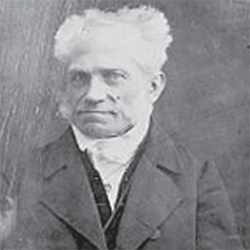
In an essay “On Women,” published in 1851 [7], Schopenhauer (pictured right) expressed his opposition to what he called Teutonic-Christian stupidity of reflexive unexamined reverence (abgeschmackten Weiberveneration) for the female. He wrote that “women are directly fitted for acting as the nurses and teachers of our early childhood by the fact that they are themselves childish, frivolous, and short-sighted”; he added that “women are deficient in artistic faculties and sense of justice,” and expressed opposition to monogamy. In addition, he claimed that “woman is by nature meant to obey.” Indeed, he has been labeled a misogynist without rival in Western philosophy. And, although the essay does offer some positive assessments of woman, it is easy to imagine the comments and reactions such ideas would trigger today.
Inherited Traits
Schopenhauer believed that personality and intellect were inherited. He quotes Horace, “From the brave and good are the brave descended” (Odes) and Shakespeare’s line from Cymbeline: King of Britain (1611), “Cowards father cowards, and base things sire base” [8]. Well, better restrain comments or judgments! In German- like fashion, Gut, besser Bemerkungen oder Urteile zurückhalten!
Mechanistically, Schopenhauer believed one inherits one’s level of intellect through one’s mother and personal character through one’s father. This belief in the inheritability of traits informed Schopenhauer’s view of love, placing it at the highest level of importance. What it all turns upon is nothing less than the composition of the next generation: “It is not the weal or woe [weh oder wehe] of any one individual but that of the human race to come, which is here at stake.” This view of the importance for the species was reflected in his views on eugenics or good breeding. In this respect, Schopenhauer wrote,
With our knowledge of the complete unalterability both of character and of mental faculties, we are led to the view that a real and thorough improvement of the human race might be reached not so much from outside as from within, not so much by theory and instruction as rather by the path of generation. If we could castrate all scoundrels and stick all stupid geese in a convent, and give men of noble character a whole harem, and procure men, and indeed thorough men, for all girls of intellect and understanding, then a generation would soon arise which would produce a better age.
In another context, Schopenhauer reiterated his antidemocratic-eugenic thesis:
If you want Utopian plans, I would say, the only solution to the problem is the despotism of the wise and noble members of a genuine aristocracy, a genuine nobility, achieved by mating the most magnanimous men with the cleverest and most gifted women.
Comments … better let us leave them out. Can the reader imagine the reactions that any of these concepts, stated so casually, would trigger in this 21st century?
Animal Welfare
Schopenhauer was very concerned about the welfare of animals. For him, all individual animals, including humans, are essentially the same, being phenomenal manifestations of the one underlying Will. The word will designated, for him, force, power, impulse, energy, and desire; it is the closest word we have that can signify both the real essence of all external things and our own direct, inner experience. Since every living thing possesses will, then humans and animals are fundamentally the same and can recognize themselves in each other.
For this reason, Schopenhauer claimed that a good person would have sympathy for animals, our fellow sufferers. Compassion for animals is intimately associated with goodness of character, and it may be confidently asserted that he who is cruel to living creatures cannot be a good human. The assumption that animals are without rights, along with the illusion that our treatment of them has no moral significance, is a positively outrageous example of Western crudity and barbarity. Universal compassion is the only guarantee of morality. In 1841, Schopenhauer praised the establishment in London of the Society for the Prevention of Cruelty to Animals and the Animals’ Friends Society in Philadelphia.
Eventual Success
Schopenhauer grew into one of the greatest pessimists in the history of philosophy. “Life is a sorry business,” he declared. Yet, he concluded, “I have resolved to spend it reflecting upon it.” One day, on an excursion to the countryside, a male friend suggested they should attempt to make the acquaintance of women. Schopenhauer quashed the plan, arguing that “life is so short, questionable and evanescent that it is not worth the trouble of major effort.” In 1833, having failed in love, academia, and publishing, Schopenhauer moved to a modest apartment in Frankfurt am Main. His closest relationships began to be with a succession of poodles, whom he felt had a gentleness and humility humans lacked (Figure 4).
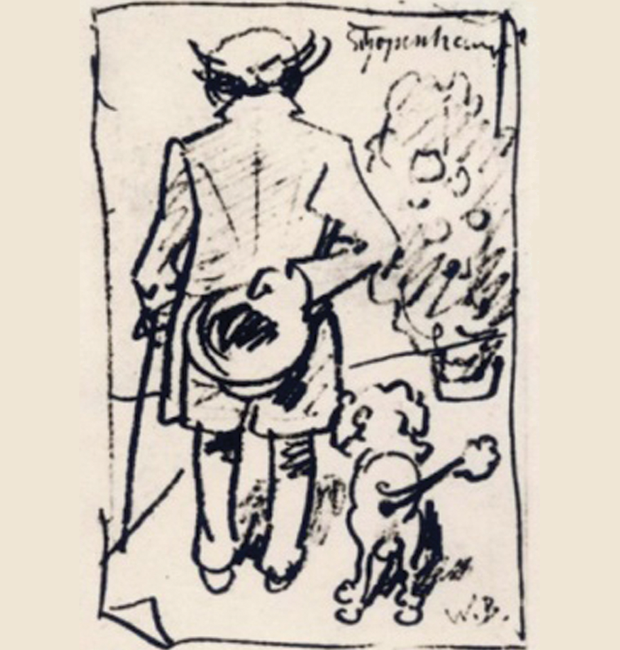
Then, in 1851, he published a selection of essays and aphorisms, Parerga and Paralipomena (Greek for “appendices” and “omissions,” respectively), a collection of philosophical reflections compiled for those who had already embraced philosophy. The collection is divided into two volumes: the parerga and, thereafter, the paralipomena to that philosophy (read, “his philosophy”) [9]. To the author’s surprise, the book became a bestseller and soon his fame spread across Europe. Lectures on his philosophy began to be offered at the universities of Bonn, Breslau, and Jena. He even received fan mail. “After one has spent a long life in insignificance and disregard, they come at the end with drums and trumpets” was his response, but he also felt satisfaction.
Most importantly, Schopenhauer underlines what he termed the will to life, defined as an inherent drive within human beings to stay alive and have children. Such will to life leads even committed depressives to fight for survival when they are threatened by a shipwreck or grave illness. It ensures that the most cerebral, career-minded individuals will be seduced by the sight of gurgling infants or, if they remain unmoved, that they will be likely to conceive a child anyway and love it fiercely on arrival. The romantic dominates life because “what is decided by it is nothing less than the composition of the next generation … the existence and special constitution of the human race in times to come.”
Nonetheless, one of the most profound mysteries of love is “why him, why her?” Why, of all the possible candidates, did our desire settle so strongly on this creature; why did we come to treasure them above all others when their dinner conversation was not always the most enlightening nor their habits the most appealing? Love is nothing but the conscious manifestation of the will to life’s discovery of an ideal coparent. “There is something quite peculiar to be found in the deep, unconscious seriousness with which two young people of opposite sex regard each other when they meet for the first time, the searching and penetrating glance they cast at each other,” he wrote.
And what is the will to life seeking through such examination? The will to life must ensure that the next generation will be psychologically and physiologically fit enough to survive in a hazardous world, and so it seeks that children be well proportioned in limb (neither too short nor too tall, too fat nor thin) and stable of mind (neither too timid nor too reckless, neither too cold nor too emotional). No doubt, and unfortunately, all these selection concepts sound as prophetic philosophical preface to Nazism. Such a theory of attraction led Schopenhauer to a conclusion so woeful, namely, that a person who is highly suitable for his child is almost never suitable. Many romantic “love at first sight” scenarios would be instantly shattered into pieces!
The will to life’s ability to further its own ends rather than our happiness may, Schopenhauer’s theory implies, be sensed with particular clarity in the strong desire to spend a few minutes alone in the kitchen that frequently befalls people immediately after making love: “Has it not been observed how after copulation the devil’s laughter is heard.” There is no need to hate ourselves. One day we will come across someone who can find us wonderful and who will feel exceptionally natural and open with us.
“There is only one inborn error, and that is the notion that we exist in order to be happy,” he wrote. “So long as we persist in this error, the world seems to us full of contradictions and disappointment.” However, there is probably one advantage. We may have to fight for survival and hunt for partners and have children, but we can, in addition, go to the theater, the opera, and the concert hall; in bed in the evenings, we can read novels, philosophy books, and epic poems: it is in these activities that Schopenhauer located a supreme source of relief from the demands of the will to life. What we encounter in works of art and philosophy are objective versions of our own pains and struggles. We may be obliged to continue burrowing underground, but, through creative works, we can at least acquire moments of insight into our woes, which spare us feelings of alarm and isolation (even persecution) at being afflicted by them. In their different ways, art and philosophy help us, in Schopenhauer’s words, to turn pain into knowledge. We must, between periods of digging in the dark, endeavor always to transform our tears into knowledge.
Schopenhauer’s Concepts Most Related to Bioengineering
In Chapter 9, Volume I, page 42 (see [2]), Schopenhauer states that “concepts can be called representations of representations,” and such reflection needs to be stressed as essential. Five cases come up that directly link Schopenhauer’s philosophy to bioengineering, biomedical engineering, and biotechnology.
Case 1: This is the case when two concepts are equal in all respects, that is, when there is full superposition; for example, ruminants and cloven-hoof animals. Ruminantia are large grazing mammals, such as cattle, goats, sheep, deer, and antelope. They employ foregut fermentation. They digest food in two steps, chewing and swallowing in the normal way to begin with and then regurgitating the semidigested cud to rechew it and thus extract the maximum possible food value. A cloven-hoof, cleft-hoof, or split-hoof animal has hoofs split into two toes. They are members of the order Artiodactyla (cattle, deer, antelopes, gazelles, goats, and sheep).
Obviously, this is the simplest case, similar to the statement saying that any object or element is equal to itself, called the identity principle. In logic, the law of identity (LOI) is the first of the three classical laws of thought: each thing is identical to itself, be it universal or particular, and is composed of its own unique set of characteristic qualities, or features, which the ancient Greeks called its essence. That is,
a = a, or, for all x, x = x. (1)
In logical discourse, violations of the LOI result in the informal logical fallacy known as equivocation. That is, we cannot use the same term in the same discourse while having it signify different meanings, even though often different meanings are conventionally prescribed to that term. In everyday language, violations of the LOI introduce ambiguity into the discourse, making it difficult to form an interpretation at the desired level of specificity. Disambiguation refers to the removal of ambiguity by making something clear; disambiguation narrows down the meaning of words and hence distinguishes between different meanings of words [10].
Case 2: The sphere of one concept wholly includes that of another (Figure 5). The large set of animals A contains the smaller set of horses H, or of any other specific group.
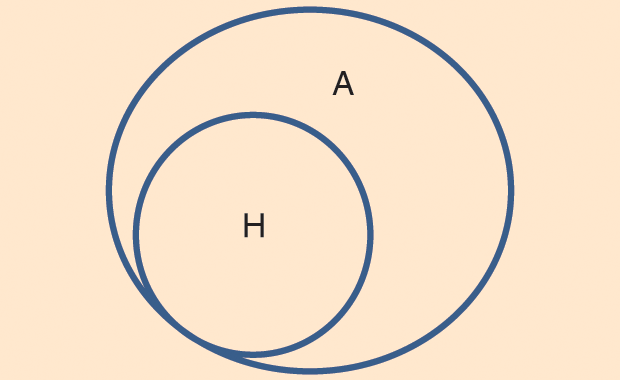
Case 3: A circle (it can also be thought of as a sphere in space) includes two or several sets of elements that exclude one another and, at the same time, fill the circle (or sphere); say, the set of right (R), acute (A), and obtuse (O) angles, as indicated in Figure 6.
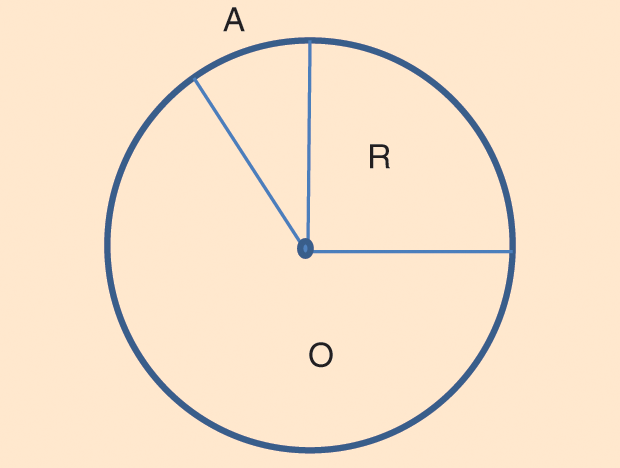
Case 4: Two circles (or spheres, if in space) include each a part of the other (Figure 7), called an intersection.
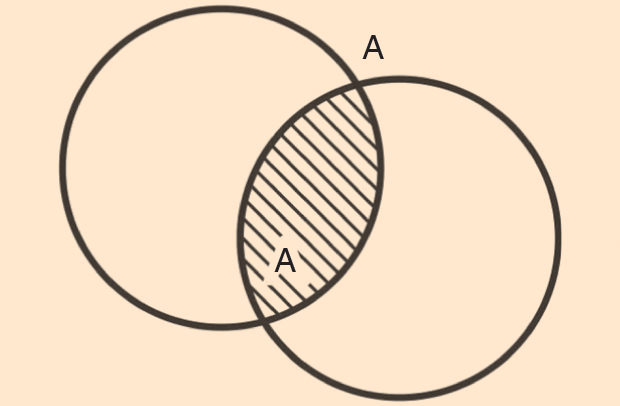
Case 5: Two circles (or spheres, if in space) lie within a third sphere, often much larger, but do not fill the latter (Figure 8). Case 5 applies to all concepts whose areas (or spheres) have nothing immediately in common, for the larger one includes them. Think of examples such as the solar system containing planets and satellites.
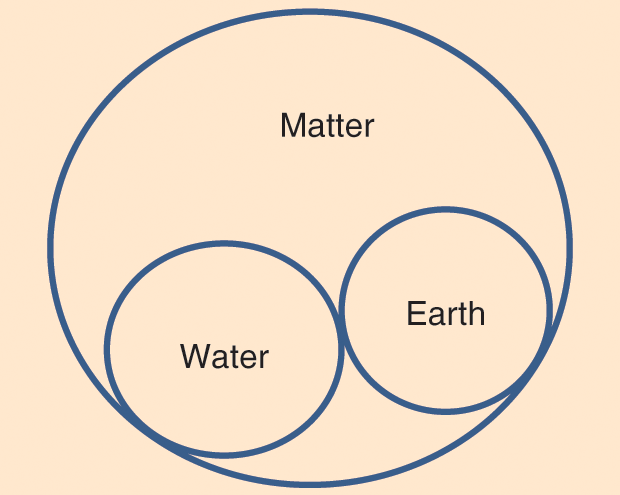
Figure 8 could be described in logical terms by means of the Venn diagrams conceived of by John Venn (1834–1923), British mathematician and logician, around 1880. (Remember that Schopenhauer passed away 20 years before they were described.) A Venn diagram shows all possible logical relations among a finite collection of different sets. These diagrams depict elements as points in the plane and sets as regions inside closed curves. The diagrams consist of multiple overlapping closed curves, usually circles, each representing a set. The points inside a curve, labeled S, represent elements of the set S; points outside the boundary represent elements not in the set S.
Thus, for example, the set of all elements that are members of both sets S and T, S ∩ T is represented visually by the area of overlap of the regions S and T (precisely, as depicted in Figure 7). Significant developments growing out of this logic—many of which are fundamental for current computer, communication, and processing signal analysis—include the already legendary contributions of George Boole [11] and more modern contributions by Montgomery Phister [12].
All combinations of concepts may be referred to the five cases described by Schopenhauer, and from them the whole theory of judgments can be derived, of their conversion, contraposition, reciprocation, or disjunction.
Discussion and Conclusions
We have briefly surveyed Schopenhauer life and ideas and found many contradictions and conflicts, some even in blunt contrast to 21st century ideas [13]. Nonetheless, his stature as a pioneering and revolutionary philosopher has not waned. Regarding our objective described at the beginning of the article, we conclude that there is considerable epistemological background in his contributions, especially in the last section.
Two final thoughts must be mentioned. In Chapter 10, Schopenhauer states that the concept of consciousness coincides with that of representation in general, of whatever kind it may be. To the plant we attribute life but not consciousness. Rational knowledge (Wissen) is abstract consciousness. In Chapter 11, he says that the opposite of rational knowledge is feeling (Gefühl). These are still subjects to keep in mind, especially considering the highly troubled world in which humankind is now immersed.
Acknowledgments
The drawings are by Gustavo Idemi (gustavo.idemi@gmail.com), a professional artist from San Juan City, West Argentina.
References
- Wikipedia. Arthur Schopenhauer. [Online].
- A. Schopenhauer, Die Welt als Will und Vorstellung, vol. I and II, 1818 (Transl.: in E. F. J. Payne, Ed., The World as Will and Representation. Indian Hills, CO: The Falcon’s Wing Press, 1958).
- Biografia y Vidas. (2018). Arthur Schopenhauer. [Online].
- J. Bernstein. (2018). Erwin Schrödinger: Austrian physicist. Encyclopedia Britannica. [Online].
- Wikipedia. On visions and colors. [Online].
- The School of Life. (2017, Apr. 18). The great philosophers: Arthur Schopenhauer. The Philosopher’s Mail. [Online].
- A. Schopenhauer. On women. The Absolute. [Online].
- Wikipedia. Cymbeline. [Online].
- Wikipedia. Parerga and paralipomena. [Online].
- Vocabulary.com. (2018). Disambiguation. [Online].
- G. Boole, An Investigation of the Laws of Thought, on Which Are Founded the Mathematical Theories of Logic and Probabilities. Dover Publications, 1854.
- M. Phister, Logical Design of Digital Computers. New York: Wiley, 1958.
- M. E. Valentinuzzi, “Technological acceleration: A few musings. A short break to think over: To be free or not to be free?” IEEE Pulse, vol. 6, no. 6, p. 39, 2015.


